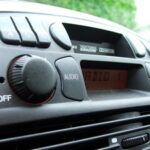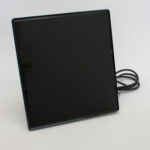While AM radio’s popularity for music listening has been eclipsed by the FM band’s higher sound quality, it is still quite popular for sports, news, and talk shows. AM radio listeners also have the advantage of being able to hear more distant stations, especially at night. Because AM radio doesn’t work the same way as other bands, different techniques are needed to improve the reception.
Rather than a metal telescoping antenna, a horizontal bar inside the radio (called a “ferrite rod”) is used for receiving AM radio. Because of this, it is necessary to rotate the entire radio to obtain the best reception, unless it has a direction-finder antenna. Very large or heavy radios, such as stereo receivers, usually aren’t best for AM listening because they are difficult to rotate. However, some large radios have a short horizontal direction-finder antenna on the top, which can easily be rotated. This allows the antenna to be pointed for the best reception without rotating the entire unit. A few receiver models with direction-finder antennas are the Realistic SW-100, Rhapsody RY-610, and Electro Brand 2971.
Using a long antenna wire, such as the wire connected to a rooftop television antenna, can substantially improve AM radio reception. A few receivers have a jack or screw for connecting an AM antenna, such as the Optimus 12-603A. If your radio doesn’t have this, you may be able to improve reception by wrapping the end of wire around it or taping a coiled section of wire to its back, but the effectiveness of this depends on the radio model and wire length.
AM radio is more subject to interference than FM or TV bands. Thunderstorms, computers, and televisions can all produce radio interference. If a computer is causing severe interference, using a battery-powered AM radio (rather than one that is plugged in) may improve reception in some cases. Pointing the receiver or its direction-finder away from the source of interference may be helpful as well. In automobiles, traffic lights and overpasses can also interfere with AM reception.
Local stations usually can be received most clearly during the day, while distant stations – often as many as 600 miles away – are strongest at night. Reception of weak distant stations and interference at night causes local stations to be more difficult to receive. When trying to receive a local station at night, try disconnecting any external antennas which are attached to the receiver. Also, if it has a sensitivity switch or knob, change it to the “Local” setting.
AM reception also varies greatly depending upon the radio you are using. Pocket radios and inexpensive alarm clocks tend to have poor AM reception, while large multiband or “Extended Range” receivers often have better reception. AM reception on digital receivers is frequently not as good as that of analog units, but this is not always the case. AM reception on car radios is usually very good, while home stereo receivers are generally in the fair-to-good range depending upon the brand/model.
Many sports and talk programs on AM radio are syndicated so that they are broadcast on more than one station. If the particular station you are listening to isn’t referred to by the program’s host, it is probably syndicated. If so, be sure to occasionally tune across the dial and check for stronger stations which are broadcasting the same program.
Taking these tips into consideration should help you achieve clearer reception of your favorite AM radio programs.


